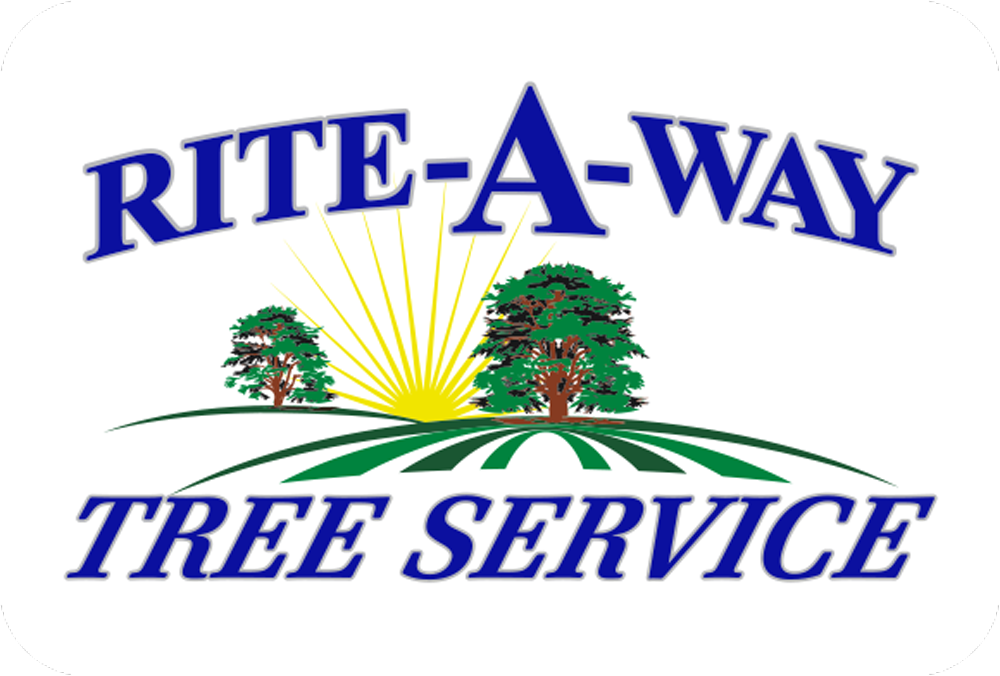What to Look Out For
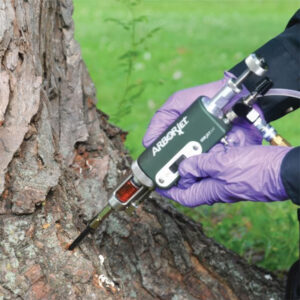 The appearance, health, and growth of your trees can be adversely effected by various pests and diseases. Regular tree inspections, best practices, and appropriate use of chemicals can help prevent and/or treat these problems.
The appearance, health, and growth of your trees can be adversely effected by various pests and diseases. Regular tree inspections, best practices, and appropriate use of chemicals can help prevent and/or treat these problems.
Some of the common tree pests and diseases include insect infestations, fungal infections, bacterial infections, and environmental stressors. Proper identification and management of these problems are crucial to maintain tree health and longevity.
Rite-A-Way Tree Service can diagnose tree pest and disease problems and help create the best plan forward to deal with them. Call Rite-A-Way at 314-427-7325 to schedule one of our expert arborists to look at your trees.
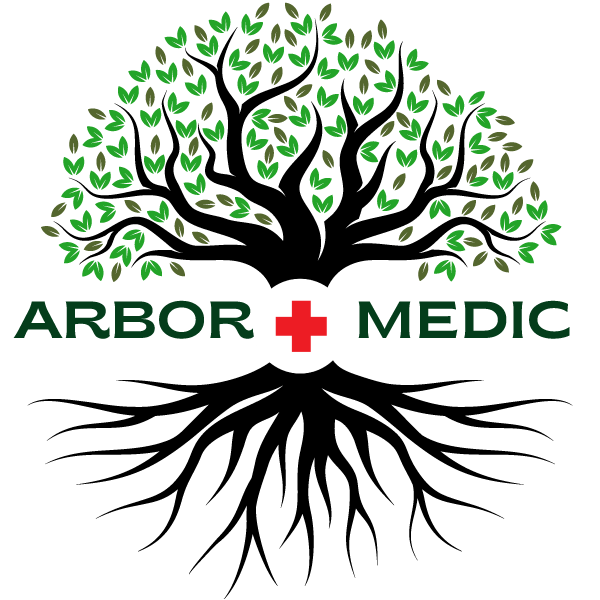
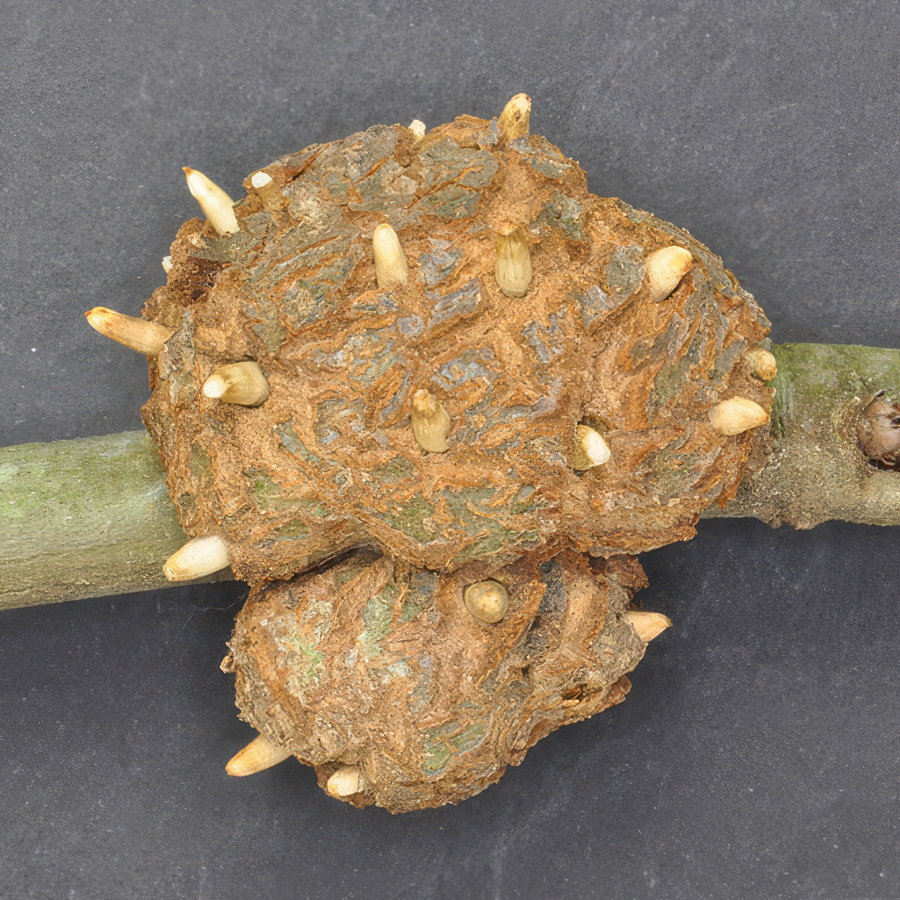
Horned Oak Gall Wasp
The horned oak gall is a golf ball-sized growth caused by a small wasp insect (Callirhytis cornigera) which can cause extreme disfiguring and dieback of certain oak species. They are often found on young twigs and have protruding horns through which young females emerge to continue the cycle.
The horned oak gall wasp occurs from southern Canada and throughout the Midwest. It attacks the twigs of pin, scrub, black, blackjack, and water oaks. Infestations on young trees can be the most devastating, but older trees will be dangerously affected as well. Galls prevent nutrients and water from moving into new growth, resulting in severe dieback.
Treatments for Horned Oak Gall
Trunk injection with TREE-äge® (Emamectin benzoate) or TREE-äge® G4 will provide both preventative and curative control depending on the time of year treatment is applied. We recommend treatment in September of this year, or early spring next year. Treatment in September will reduce early pest damage next spring. TREE-äge will provide control for a minimum of a year, and potentially up to two years. Treatment are very effective in managing stem and twig insects when applied as a dilute injection prior to spring insect emergence. The most effective treatments are applied to trees at risk of infestation. Treatment will prevent new galls but will not eliminate old ones and will additionally protect your trees from up to 51 other pests.
Call Rite-A-Way Tree Service for a Free Quote: 314-427-7325. Let Rite-A-Way properly treat your tree to help keep it healthy and increase its longevity.
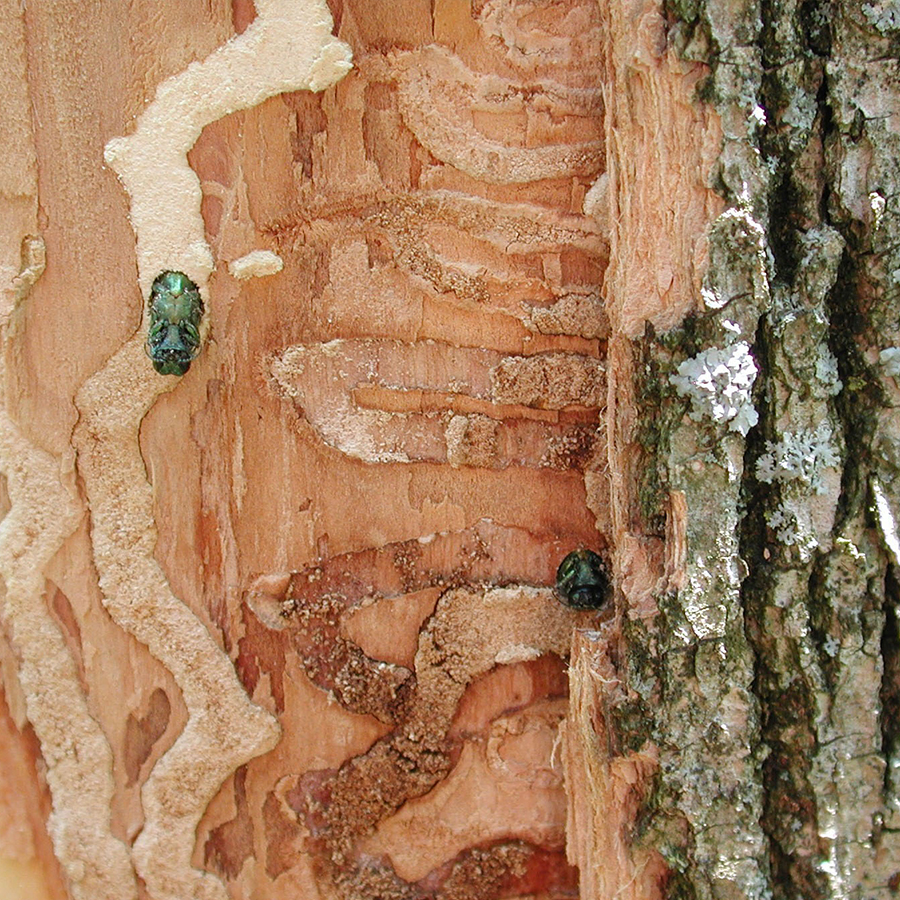
Emerald Ash Borer
Emerald ash borer (EAB) is an invasive beetle that attacks feeds on and kills ash trees. This metallic wood boring beetle has continued to spread into neighboring states and eventually across the U.S. and Canada. The adult is a small, metallic green beetle only 10-15 mm in length and about 3 mm in width. The larvae live under the bark of the tree and feed in the vascular cambium, disrupting the tree’s ability to transport water and nutrients, leading to branch dieback and tree death. The adults typically emerge around June, leaving D-shaped exit holes in the bark. This ash tree insect briefly feeds in the canopy before reproducing and laying eggs in the twigs and branches.
WHAT TO LOOK FOR:
- Canopy thinning and dieback
- Epicormic (suckers) shoots on the stem
- D-shaped insect exit holes
- Larvae and tunneling under the bark
- Bark blonding (white and tan patches)
EFFECTS ON YOUR TREE
Emerald ash borer Infestation can increase quickly. This can cause serious structural weakness in your tree and may lead to a tremendous hazard for your home and landscape.
Treatments for Emerald Ash Borer
Independent studies strongly recommend that treatments be applied early, before extensive disruption to the vascular tissues occurs. Dieback symptoms should be <40%. Arborjet recommends treatment when EAB is detected in your area, but trees still appear healthy for best outcomes. Treat ash with either TREE-äge® Insecticide (emamectin benzoate) or IMA-jet (imidacloprid). TREE-äge and IMA-jet will both kill the EAB larvae inside the tree.
See the TREE-äge and IMA-jet labels for dosage rate based on tree size.
To give the tree a greater health benefit, a follow-up application of MIN-jet Iron or NutriRoot is recommended, the specific formulation dependent upon soil type. NutriRoot™, will supply phosphorous, potassium, iron, manganese, humectants, humic acid and a low dose of nitrogen for healthy leaf and root development. MIN-jet Iron supplies both iron and manganese, micro-elements that may be sequestered in high pH soils, but essential to healthy, green foliage.
Call Rite-A-Way Tree Service for a Free Quote: 314-427-7325.
We will properly treat your tree to help keep it healthy and increase its longevity.
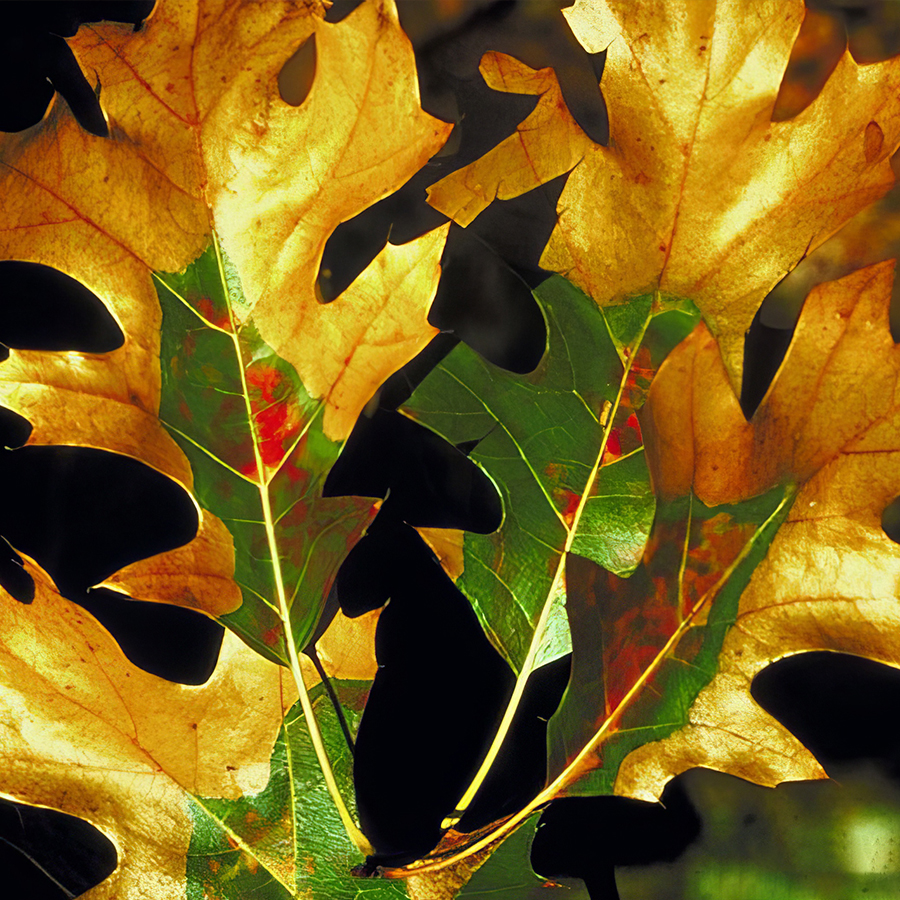
Oak Wilt Disease
Oak Wilt is a lethal disease that is specific to oaks, especially species in the red oak group but it can also affect white oaks.
The fungus responsible, Bretziella fagacearum, invades the tree, causing it to die. It is spread through root grafts between neighboring trees and by insects. Red Oaks are particularly susceptible to oak wilt. The infection causes leaf discoloration, defoliation and death in a very short period of time (from two months to one year). Fungal mats will form under the bark and force outwards, cracking the bark of the tree. White oaks are more tolerant of oak wilt infection. Fungal mats will not form and it will take much longer for the tree to succumb to the disease. White oaks will show infected annual rings when viewed in cross section.
In Missouri, the oak wilt fungus is spread primarily when sap-feeding beetles carry oak wilt spores to fresh wounds during the early part of the growing season. Once established in a tree, oak wilt can move though root grafts to nearby oaks.
WHAT TO LOOK FOR:
In Red Oaks:
Browning and wilting of leaves in the upper crown in early summer.
In White Oaks:
Browning and wilting of leaves in scattered branches and wilting leaves in the crown.
Wilted leaves look olive drab or light tan to bronze starting at the margins and progressing toward the leaf base. Brown or black streaking may be seen under the bark of wilted branches in both groups of oak.
In red oaks, rapid defoliation (leaf loss) can occur within two to six weeks of initial infection, and death occurs within a year. White oaks may take years to die from the infection.
When conditions are ideal for oak wilt, fungal mats form under the bark of dead red oaks in the spring following tree death. The fungal mats cause cracks in the bark and emit a sweet, fermenting odor that attracts sap-feeding insects that spread the fungus. Squirrels may chew through the bark to expose these areas.
Treatments for Oak Wilt
We recommend a trunk injection of Propizol. Propiconazole is a systemic fungicide that will suppress then fungus. Because Oak Wilt is spread through root grafts and insect carriers, we recommend the treatment of non-infected oaks in close proximity to the infected trees to slow the spread of the disease. When treating multiple trees, it is recommended to disinfect drill bits and injection equipment between trees.
Call Rite-A-Way Tree Service for a Free Quote: 314-427-7325. Rite-A-Way will properly treat your tree to help keep it healthy and increase its longevity.
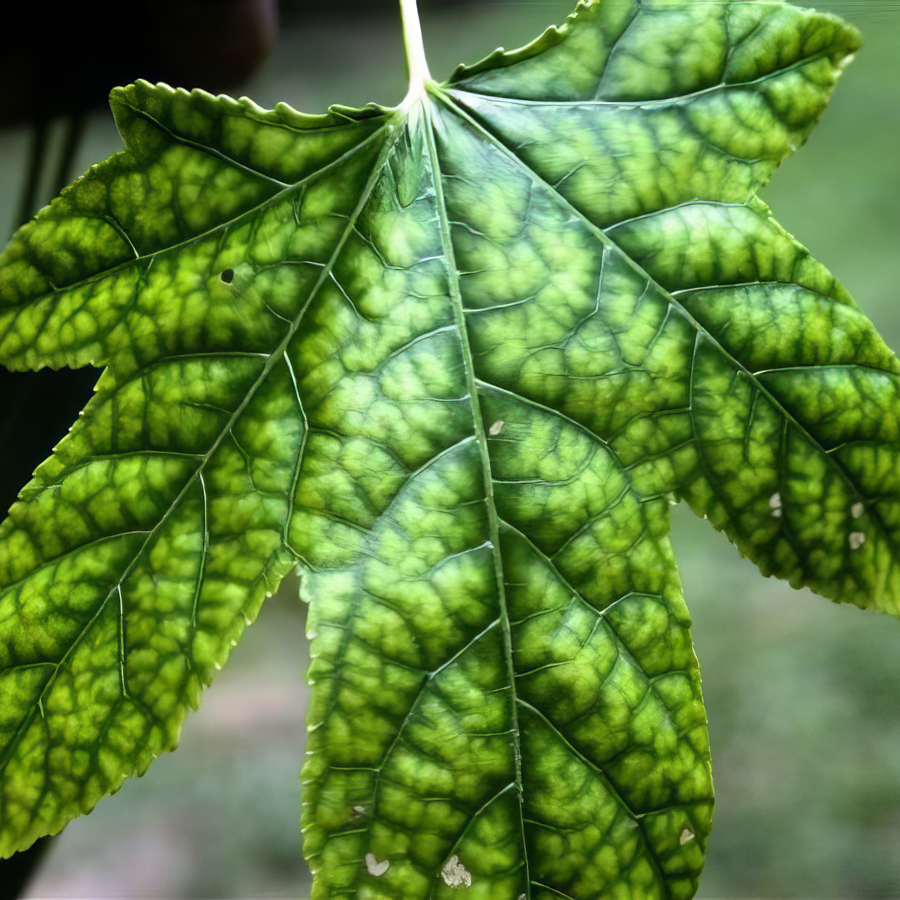
Chlorosis
This condition, if allowed to progress, will cause slow growth, leaf loss, and eventually tree death. Chlorosis is often caused by deficiencies of the micro-elements iron and manganese, and is particularly prevalent in oak. In alkaline soils, iron and manganese become insoluble and unavailable to the tree. Trees growing in poorly drained soils are also susceptible to iron chlorosis.
Treatments for Chlorosis
We recommend a two-pronged approach to treating foliar chlorosis.
Trunk Injection: by injecting to apply Mn-jet Fe™ which is specially formulated for iron deficiency, minerals which are deficient in the tree directly into the xylem tissue, these minerals available to the tree immediately; thus, it is the fastest way to alleviate symptoms of chlorosis and improve the health of the tree. By rapidly providing the minerals the tree needs, it is able to respond rapidly and generally will have darker, healthier leaves within days or weeks of application.
Soil Application: Arborjet recommends a supplemental follow-up application of NutriRoot®, which should be applied as a soil drench. NutriRoot is a unique two-component formulation of a water manager and nutrient blend. The nutritional supplement includes humic acid, kelp, and micro-nutrients designed to enhance soil conditions for accelerated root development. NutriRoot makes watering more efficient, reduces plant stress, and increases water storage in plants.
Call Rite-A-Way Call for a Free Quote: 314-427-7325. They will properly treat your tree to help keep it healthy and increase its longevity.
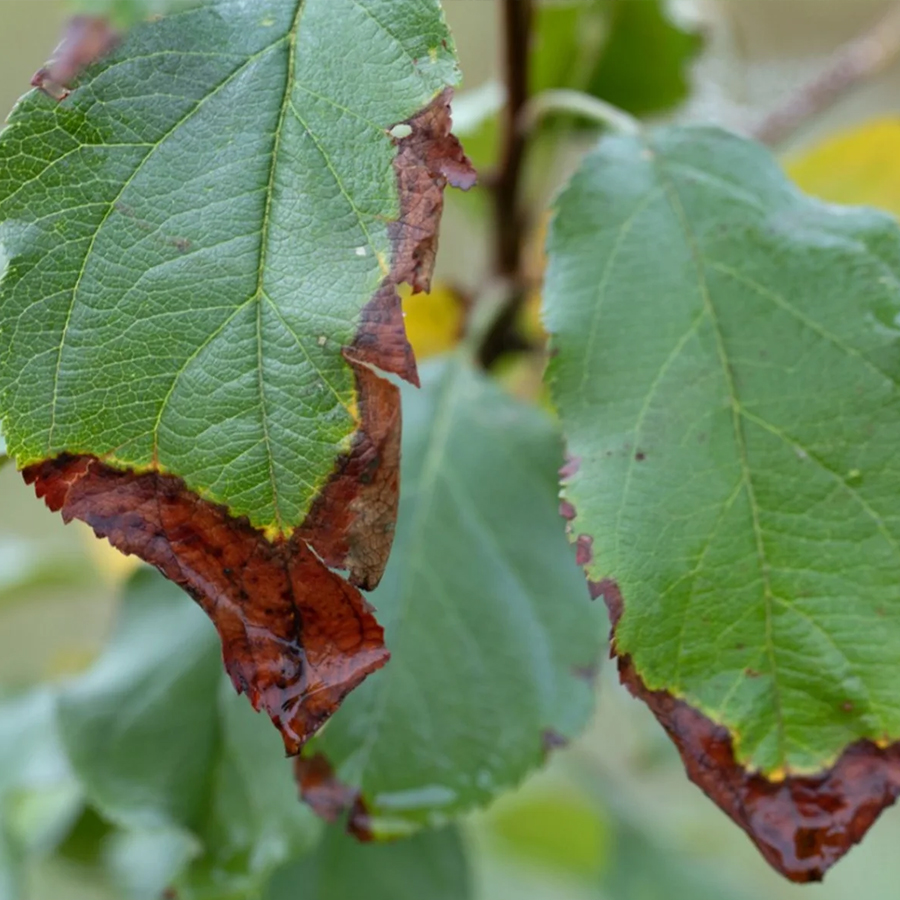
Fire Blight
Fire blight is a bacterial disease that affects a variety of ornamental trees especially in the rose family, including apples, pears, and crabapples.
The symptoms include wilting, blackening, sunken areas (cankers) and shriveling of leaves, flowers, and twigs.
The tissue from the canker to the end of the branch or twig turn black and looks like it has been burned and should be completely removed.
WHAT TO LOOK FOR:
- Twig cankers
- Wilting of new growth in the shape of a shepherd’s hook
- Tip dieback
HOW IT EFFECTS YOUR TREE
Once established, fire blight typically returns on an annual basis and will kill the current season’s growth where cankers exist. Severe cases may kill the whole tree.
WHAT TO DO
Fire blight spreads rapidly, and infected parts should be pruned and disposed of immediately. The use of systemic injections, topical sprays and proper pruning techniques can help prevent fire blight.
In serious cases pruning is required to remove the cankers, which eliminates the bacteria.
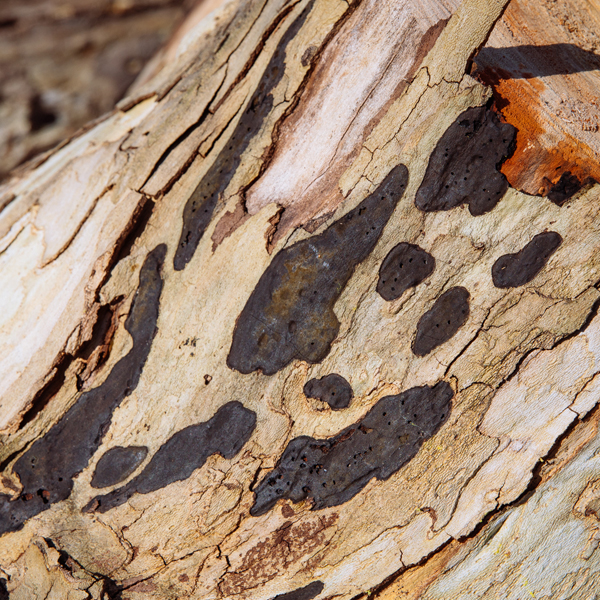
Anthracnose
Anthracnose is a fungal disease that affects a wide range of trees, including dogwoods, maple, sycamores, and oaks. It causes leaf spotting, discoloration, and defoliation. The fungus thrives in wet and humid conditions.
WHAT TO LOOK FOR:
- Spotted, blotched, or distorted leaves
- A scorched appearance from a distance
- Partial or complete defoliation (loss of leaves) in early spring
- Shoot blight, twig cankers, and dieback when infections are severe
WHAT TO DO
Proper tree spacing is the best way to prevent Anthracnose. Pruning, and maintenance practices that promote good air circulation and reduce leaf moisture are also good peventative measures.
Other good tree care practices that reduce stress like mulching, watering, avoiding wounds and improving air flow through the canopy with selective pruning also help.
Reduce future infections through raking and destroying fallen leaves.
Before symptoms appear, fungicides can be applied as a preventive measure. To be effective, it is necessary to fully cover the buds and twigs. Use fungicides containing the active ingredients propiconazole, thiophanate methyl, copper, mancozeb, or chlorothalonil. Carefully read and follow fungicide label instructions.
Call Rite-A-Way Tree Service for a Free Quote: 314-427-7325.
We can properly diagnose your tree’s problems and determine the best course of action to take. When possible, we can treat your tree to help maintain its help. If the tree is untreatable, we can create a plan to remove and dispose of your tree and avoid any potential future problems.
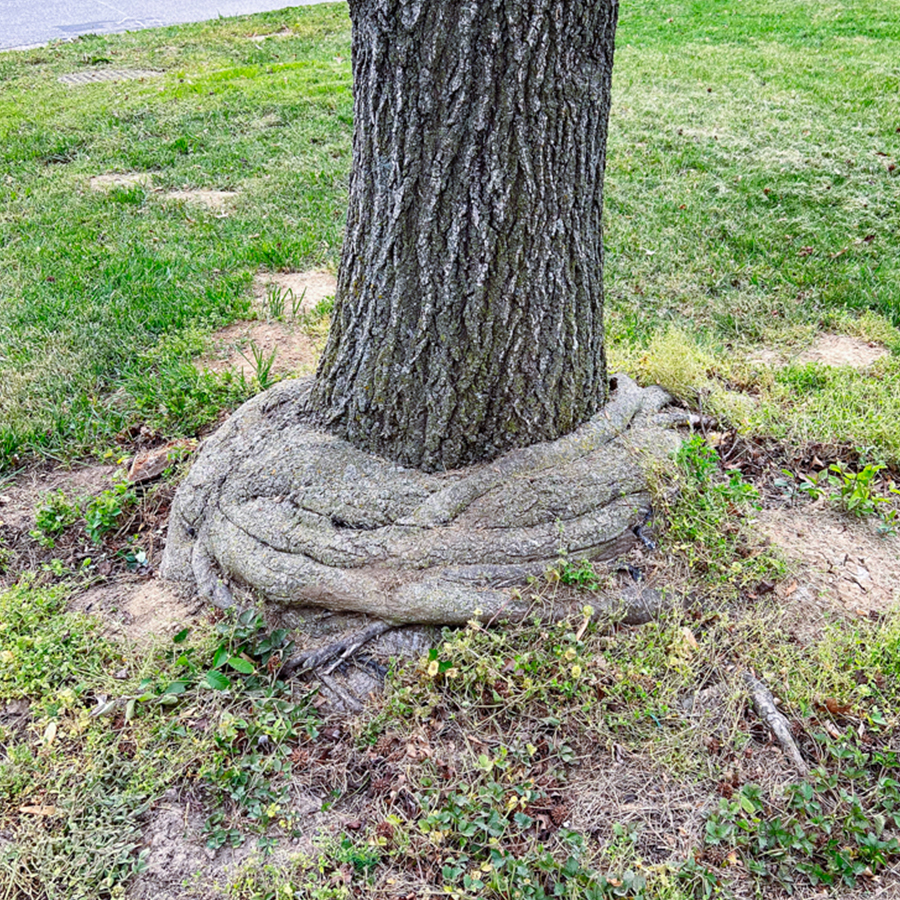
Stem Girdling Roots
Stem girdling roots are roots that grow around the tree trunk and are often not visible above ground. They compress and choke the tree, which interferes with the tree’s water and nutrient uptake.
WHAT TO LOOK FOR:
- Visible roots wrapped around the stem
- Lack of stem taper (root flare)
- Tip dieback
- Sparse canopy
HOW IT EFFECTS YOUR TREE
Stem girdling roots that wrap around the base of the tree will lead to serious issues and can lead to the tree falling over. They compress and choke the tree, which interferes with the tree’s water and nutrient uptake, leading to stunted growth, leaf yellowing, and premature death.
WHAT TO DO
Prevention and early detection can help mitigate the effects of stem girdling roots.
The best way to prevent stem girdling roots is to plant trees correctly, ensuring that the roots are adequately spread out and not encircling the trunk.
If girdling roots are identified, roots may be pruned to alleviate constriction. In severe cases, special tools may need to be used to remove soil from around the base of the tree to gain access to the roots without harming them.
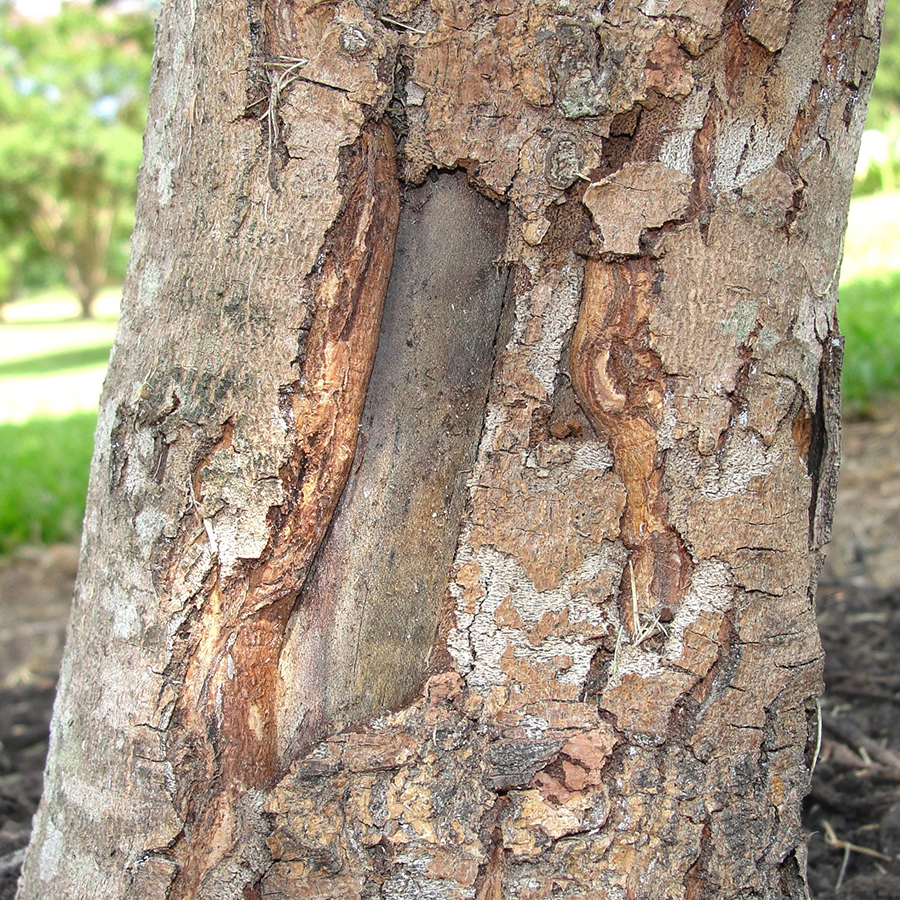
Sunscald
Sunscald is a condition that occurs when the bark on the tree’s trunk gets damaged by excessive exposure to sunlight. It often happens during winter when the sun is low and intense, and the temperatures are freezing. Sunscald can cause the bark to crack and split, making the tree more susceptible to infections and pests.
WHAT TO LOOK FOR
- Vertical bark splits
- Wounding on the SouthWest side of the trunk
- Discolored bark
- Tip dieback
HOW IT EFFECTS YOUR TREE
Young, small caliper trees with severe sunscald damage may need to be replaced. Trees with minimal damage may rebound once they receive the proper attention.
WHAT TO DO
Sunscald can be prevented by wrapping the trunks of thin barked trees with a light-colored tree wrap or paint it with a white latex paint.
Trees that have sustained damage should be maintained by good practices such as watering during drought, mulch, and pest management.
